
Udupi is a city in the Indian state of Karnataka. Udupi is situated about 55 km (34 mi) north of the educational, commercial and industrial hub of Mangalore and about 422 km (262 mi) west of state capital Bangalore by road.
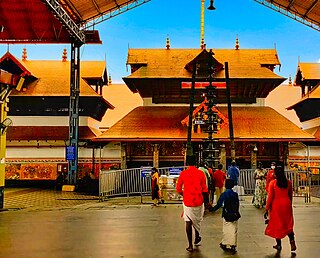
GuruvayurIPA:[guɾuʋɐːjuːr]) is a municipal temple town in Thrissur district, of Kerala State in India. It is a suburban town of Thrissur city, located 27 kilometres (17 mi) from Thrissur towards the north-west. It houses the Guruvayur Shri Krishna Temple. It is located at a distance of 292 km (181 mi) from the state capital Trivandrum towards the north-west, 80 km (50 mi) from Kochi towards the north, 90 km (56 mi) from Calicut towards south.

Temple cars or Temple chariots are used to carry representations of Hindu gods around the streets of the temple on festival days. These chariots are generally manually pulled by the devotees of the deity.

Dola Purnima, also popularly known as Dolo Jatra, Doul Utsav or Deul, is a Hindu swing festival celebrated during the Holi festival of Braj region, Rajasthan, Gujarat, Odisha, Assam, Tripura and Bengal region. This festival is dedicated to the divine couple of Radha and Krishna. It is usually celebrated on the full moon night or fifteenth day of the Falgun month mainly by Gopal community.
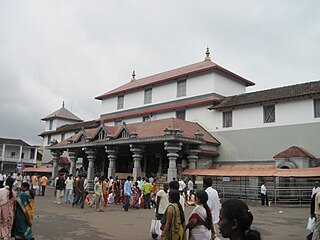
Dharmasthala is an Indian temple town on the banks of the Nethravathi River in the Belthangady taluk of the Dakshina Kannada district in Karnataka, India.

Kadri Manjunatha Temple is a historic temple in Mangalore in the state of Karnataka, India. The incharge and priests in the temple are Shivalli Madhva Brahmins.

The Gokarnanatheshwara Temple, otherwise known as Kudroli Sri Gokarnanatha Kshetra, is in the Kudroli area of Mangalore in Karnataka, India. It was consecrated by Narayana Guru. It is dedicated to Gokarnanatha, a form of Lord Shiva. This temple was built in 1912 by Adhyaksha HoigeBazar Koragappa.

Melukote in Pandavapura taluk of Mandya district, Karnataka, in southern India, is one of the sacred places in Karnataka.It is built on rocky hills, known as Yadugiri, Yaadavagiri or Yadushaila, overlooking the Cauvery valley. Melukote is about 51 km from Mysore and 133 km (83 mi) from Bangalore.

Pili Vesha in "Tiger Masque" is a folk dance unique in coastal Karnataka. Pilivēṣa is performed during Navratri to honour the Goddess Durga, whose favoured animal is the tiger. Mangalore Dasara is one of the festivals during which large number of enthusiasts participate in this ritual. It was originated in Udupi District of Karnataka and initially performed during the Krishna Janmashtami/Mosarukudike and Ganesha Chaturthi at Mangalore, Udupi, Moodabidri, Kundapur and many other places in Tulu Nadu.
Ballal is a surname from coastal Karnataka in India. It is found among Shivalli Madhva Brahmins,Hindu Samantha Arasu, Bunt and Jain Royal communities.
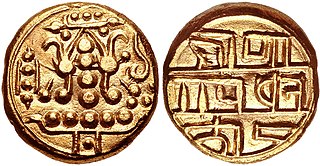
The Alupa dynasty was an ancient ruling dynasty of India. The kingdom they ruled was known as Alvakheda Arusasira and its territory spanned the coastal districts of the modern Indian state known as Karnataka. The Alupas in their prime were an independent dynasty, centuries after reigning due to the dominance of Kadambas from Banavasi, they became feudatory to them. Later they became the vassals of the Chalukyas, Rashtrakutas, Hoysalas with the change in political scenario of Southern India. Their influence over coastal Karnataka lasted for about 1200 years. There is evidence that the Alupas followed the law of matrilineal inheritance (Appekatt/Aliyasantana) since the Alupa king Soyideva was succeeded by his nephew Kulasekhara Bankideva. The legendary king who is credited with introducing matrilineality in Alva Kheda|Tulu Vishaya Kheda is named Bhuta Alupa Pandya The descendants of this dynasty still survive to this date and have spread in the karavali region and they are widely referred to as the Bunt. The Bunts follow Matrilineality instead of the common Patrilineality, and are said to be Nagavanshi Kshatriyas by their maternal origin. They can be identified with their surnames such as Shetty, Rai, Hegde, Alva, Chowta etc. Even though most Bunt are Hindus by faith now, The sizeable section of the community still follows Jainism and they are called Jain Bunt The last Alupa king to have ruled is Kulasekharadeva Alupendradeva whose inscription dated 1444 CE have been found in Mudabidri Jain Basadi.
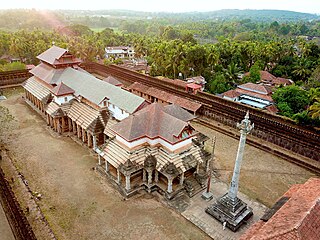
Moodabidri is a town and taluk in Dakshina Kannada district. It lies 34 km northeast of the district headquarters, Mangalore, in Karnataka, India.
Devadiga also known as Moily, Sherigar is a Hindu Community or Caste. Devadigas were traditionally temple servants and musicians in Hindu temples. Devadigas are originally from the land stretching between Karwar in Uttara Kannada district of Karnataka and Kasaragod district of Kerala and some parts of Maharashtra in west-coast of India up to the Chandragiri River and Many People live in Shivamogga and Chikmagalur too. Devadigas are quite distinct from the Ambalavasi(Semi-Brahmin)(temple servants) found elsewhere. It is believed that their two divisions, namely Kannada Devadiga (Moily) and Tulu Devadiga (Moily); were endogamous in the past.
Gurupura, Karnataka, India is a small town situated on the Phalguni, or Gurupura River. It is located about 345 kilometres west of Bangalore, the state capital, and 13 kilometres east of Mangalore, Karnataka's chief port city.
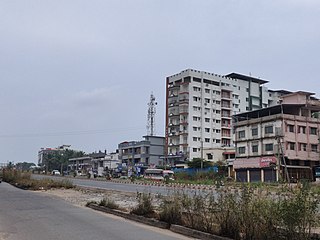
Thokottu is a commercial junction to the south of Mangalore city on National Highway 66 and the gateway to Mangalore city from the South (Kerala). It is one of the major and busiest junctions of Mangalore city wherein one road goes towards east to Deralakatte and Konaje, educational hubs with several premium educational institutions and few information technology companies, the other road towards west goes to Ullal. This junction connects Mangalore city, second major city of Karnataka with Talapady and Kerala. A flyover is constructed in the junction to reduce the congestion for the travellers travelling between Mangalore city and Kerala. The creation of educational institutions in Deralakatte and Konaje has led to the construction of many commercial complexes in the area.
Mangalore district that was partitioned from the erstwhile South Canara, has been multicultural and is a little different from the prevalent culture of the Carnataca state of India. A native of Mangalore is known as a Mangalorean in English, Kudladakulu in Tulu, Kodyaalkar in Konknni, Manglurnavaru in Kannada& Maikaaltanga in Byari.
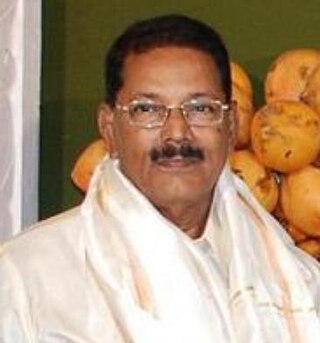
Bola Chittaranjan Shetty is a famous Tulu and Kannada writer, who was the president of the 16th Mangalore Taluk Kannada Sahitya Sammelan held in year 2010. He died at his residence on 7 August 2016, and his cremation was held at Kuthar Guthu. He was 72.
Urkeri is a small village located in the district of Uttar Kannada in the state of Karnataka in India. It has a population of about 963 persons living in around 214 households. Urkeri is a temple Village. The main deity is Lord Ganesh. Lord Ganesha is revered as the village God in these villages, in the north Kanara district. The chariot ceremony of Ganapati is celebrated on Maghi Pournima. The temple is the main attraction at Urkeri, receiving many devotees per year. Urkeri Shree Swayambhoo Devasthana is an ancient temple.

The Mangalore Dasara, is a festival in the Indian city of Mangalore organized by Acharya Mutt. It is also referred as Navarathri Festival, Vijayadashami. The tiger dance, lion dance and bear dance are the main attractions. The city is decorated with lights for the span of 10 days of the occasion.

Karppillikkavu Sree Mahadeva Temple is a temple in India, dedicated to Shiva as kirata (hunter). This temple's specialty is that the deity give dharshan to the western side. This temple is situated in Manjapra village in Ernakulam District of the Indian state of Kerala. The deity of Siva is in the Sankalppa of Kirathamoorthy that is Vettakkaran. The legend is that Prathishta was done by Kartavirya Arjuna.

















